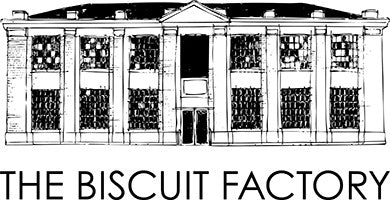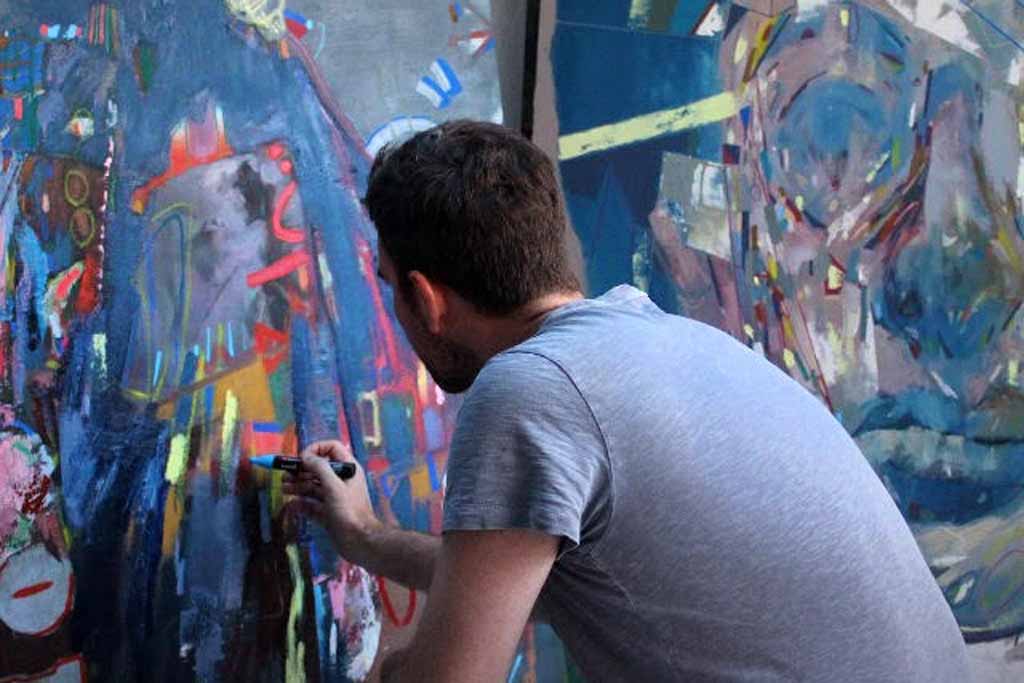In The Studio / Dan Cimmermann
Emerging British artist Dan Cimmermann has exhibited widely throughout the UK since graduating with a degree in Fine Art from Leeds Metropolitan University in 2001, including twice within the prestigious BP Portrait Prize. Cimmermann’s colourful paintings and murals are a meeting of ‘street’ and ‘studio’, a reflection upon British identity and a rebellion against societal rules of old. Through a process of reworking layers of paint and pen Cimmermann adapts classical works of 18th century portraiture, and creates new narratives and value systems. His expressive body of work encapsulates a dissatisfaction with the current system of politics and offers liberation from symbols of wealth and power.
With a solo show at The Biscuit Factory throughout the Great Exhibition of the North and a outdoor installation planned, Dan has a busy summer season ahead. We spoke to Dan about his love of street art, what inspired his new collection and what's next for his artistic practice.
How long have you been practicing? Did you attend art school or are you self-taught?
I studied Fine Art at Leeds Metropolitan University and graduated in 2001. I have always produced artwork but focused on it more seriously over the last 5 years. I also teach and use the break in term time to focus on my studio practice.
Tell us a little about you and your practice?
Chance is the most important element in my work. I’m in essence trying to balance a series of marks, colours and figurative images. I use portraiture from British history as a starting point. I want the work to evolve - there is only a loose plan for a piece of work and this can rapidly change at any stage of the painting process. I don’t use sketchbooks to experiment; this is all carried out on canvas. I work on 10 - 15 pieces at any one time. I can’t bear to waste paint so I have loose scraps of paper, canvases and prints that I will add access paint to. I could never paint in a photorealistic manner - the act of reworking, refining and often defacing an artwork is what keeps it fresh and exciting for me. A narrative or a meaning often comes to the work at a later stage when the subjects begin to balance and several layers of paint are built up.
Has your practice changed much over the years?
I’ve always been interested in figurative work. Portraiture always draws me in. To capture something of a human being is the most difficult act. Balancing this with abstract, gestural mark making in the style of Justin Mortimer or Adrien Ghenie seems to me the most exciting way to paint and has been the focus of my practice for a good while now.
I have created much more street art recently. I’ve always been influenced by big cities - in torn posters, peeling paint, graffiti, tags and accidental abstract compositions witnessed on the streets. So it seemed natural to create a mural piece. My first was commissioned by Rise Gallery in Croydon entitled ‘Bret Easton Ellis’, where I recreated a small collage of torn images on the wall of an underpass.
What sparked your interest in street art?
Living in Tokyo and London drew my attention to street art. Not only the refined pieces of work but the accidental pieces too. I love exploring cities, each with its own personality of marks and artists. I love the green colour used in New York to paint hoardings on the outside of building sites. This alongside graffiti, tags and paste up works is incredibly inspiring.
Tell us more about your recent work in Lebanon?
I went over with Rise Gallery alongside some world renowned street artists from the UK and beyond. The aim was to collaborate with Lebanese artists and working with a charitable organisation, Ahla Fawda, transform a run-down area of Beirut with art work. We painted a large bridge in Aley on the main road to Damascus. I painted an 8 metre tall wall overlooking the city next to graffiti lettering specialist Ben Eine. I also collaborated with Giacomo Run and Dotmasters on wall pieces, one in a Lebanese prison. It was an incredibly valuable learning experience to see how others worked and such a wide variety of techniques and artistic backgrounds.
Tell us more about the process of creating a large scale mural?
I scale the drawing up using a grid drawn on to a photocopied image. This is simply to get the proportions right. I’m not interested in doing an exact copy of the image - I still want a certain amount of change to occur. Often viewers think my work is unfinished - I’m not concerned with minute detail. I want my street art to be immediate and to be full of energy so drips, mistakes, signs of the grid and chance interventions are all actively sought out.
Can you tell us about your painting process and technique? Do you work from sketches or photographs? How do you select your figures?
I use British figures usually from royalty, the military or notable individuals. The idea started as I feel the history of our nation underpins everything we do, how we view the rest of the world and interact with foreigners. These were brought closer to the forefront of my mind with Brexit and contemporary issues of immigration. I have travelled a lot and learn a great deal about the view of the British people through talking to locals. It makes me realise how we still have such a strong class system in our country and the stiff upper lip of our history prevails. I see the paintings as replicating contemporary society through layers of paint and marks merged together with classical elements of portraiture and figures from history. It’s my view of how we Englishmen are trying to make sense of our identity and how confusion about our future in the EU and the world is dictated by our colonial and military past.
Tell us about your studio space? How do you usually work in the space?
A work from a small space at the top of our cottage in Wetherby, West Yorkshire. I work on several pieces at once surrounded by photocopied images and torn out pictures from books.
What inspires you?
Cities. Travel. Abstract art. People. Behaviour. Britain. Brexit.
Which artists inspire you?
Loads at any one time. Picasso grows on me the more I develop my own practice. I’m fascinated with Guernica and Les Demoiselles d’Avignon. I think they are two of the most complete paintings I’ve ever seen.
George Condo is a new artist that intrigues me. Eddie Martinez for his markmaking. I saw a recent Justin Mortimer exhibition at Parafin, London and was completely blown away. Especially his ‘Hoax’ paintings of flowers in dirty water vases. I love the looseness of Danny Fox and strive to be that free. Basquiat at the Barbican was similar to Fox - such an outpouring of personality on the canvas. Nicola Samori is another amazing artist whose work I found quite recently.
I like really dark, moody paintings. Jake Wood Evans too. Street artists inspire me with the immediacy of their work - to create such clean work at such a speed. I worked on a collaboration with Mark McClure recently and really admired his clinical approach to create such beautiful geometric lines and shapes. I thought it worked so well with my looser approach.
Tell us more about the titles of pieces from your current collection at The Biscuit Factory?
Some of the pieces included in this show reference pub names, i.e Charles Grey, Captain Cook, William Wilberforce. Pubs are a cornerstone of British society but they are always empty. Tadcaster is full of empty pubs and the village I live in has 3 pubs that never have anyone in them. I’m not a pub goer but I feel sad looking through the windows seeing one or two lonesome drinkers. I guess everyone is going to coffee shops or restaurants instead. It’s another symbol of mixed identity Britain. What are we fighting for with Brexit? Romanticism? Will we ever have back the packed local pub with the roaring fire or the thriving local mill that provides a job for life for the whole family?
What’s coming up for you this year? Do you have any other interesting projects in the pipeline?
I made a lot of links in Beirut with Rise Gallery and it looks like more work will come out of that trip. The National Bank of Lebanon actually own a piece of my work, the only non-middle eastern artist in their collection.
I’m painting a mural on the roof of Jealous Gallery, London in February. I would love to do more mural work overseas and locally. I am keen to do more collaborative work moving forwards. It’s so interesting to see how others work and adapting to complement each other’s styles and working methods. There is also a really exciting project with the Biscuit Factory this summer, to coincide with the Great Exhibition of the North.
What has been a career highlight for you so far?
I would have to say exhibiting in the BP Portrait Award at the National Portrait Gallery in London. I've always been a fan and although I feel most of the work is much too photorealistic it was a thrill to have work hung in such a major gallery space. It was extra special the first time as it was a portrait of my Dad.
***
Dan Cimmermann's headline show 'Northern Soul' is on now at The Biscuit Factory until 28 August 2018. Preview the current collection here >
Visitors can also view Dan's outdoor mural - specially comissioned for the Great Exhibition of the North - on Boyd Street, Ouseburn (next door to The Biscuit Factory, outside The Biscuit Room events suite). The mural will be on permanent display and visitors are encouraged to view the work being painted live on Sunday 24 June from 10am - 5pm.
Want to start your own art collection? Spread the cost of a piece of original artwork over 10 months, interest free!
Own Art is a programme run in partnership with Arts Council England, the Arts Council of Northern Ireland and Creative Scotland. Our Own Art scheme makes buying art easy and affordable by letting you spread the cost of your purchase over 10 months with an interest free loan.
You can borrow between £100 and £25,000 so you can start your collection from as little as £10 per month, use the scheme to part finance a larger value purchase, or combine the costs of multiple pieces. The minimum you can borrow is £100 (monthly repayment of £10), but this can be used to cover a group of lower value items whose combined total adds up to £100 or more. FIND OUT MORE >


